How to Grow Asparagus with Strawberries in Perennial Permaculture Beds
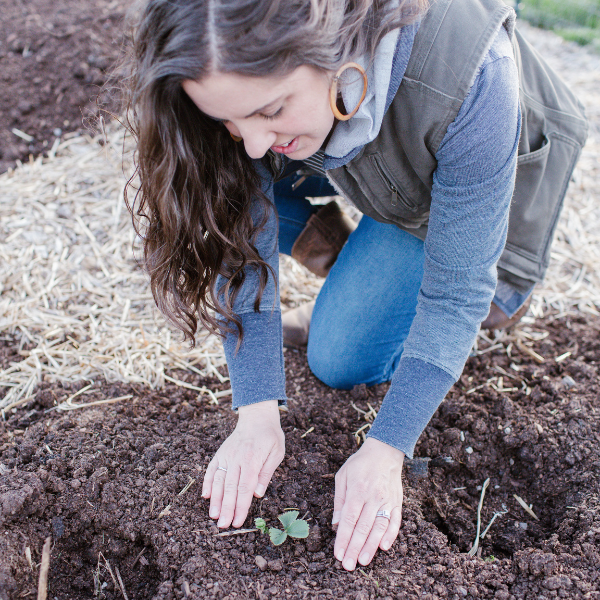
Plan your best garden with simple, step-by-step instructions!
This post may contain affiliate links, which means I make a small commission at no extra cost to you.
See my full disclosure here.
Wondering how to grow asparagus with strawberries in perennial permaculture beds? I’m glad you asked.
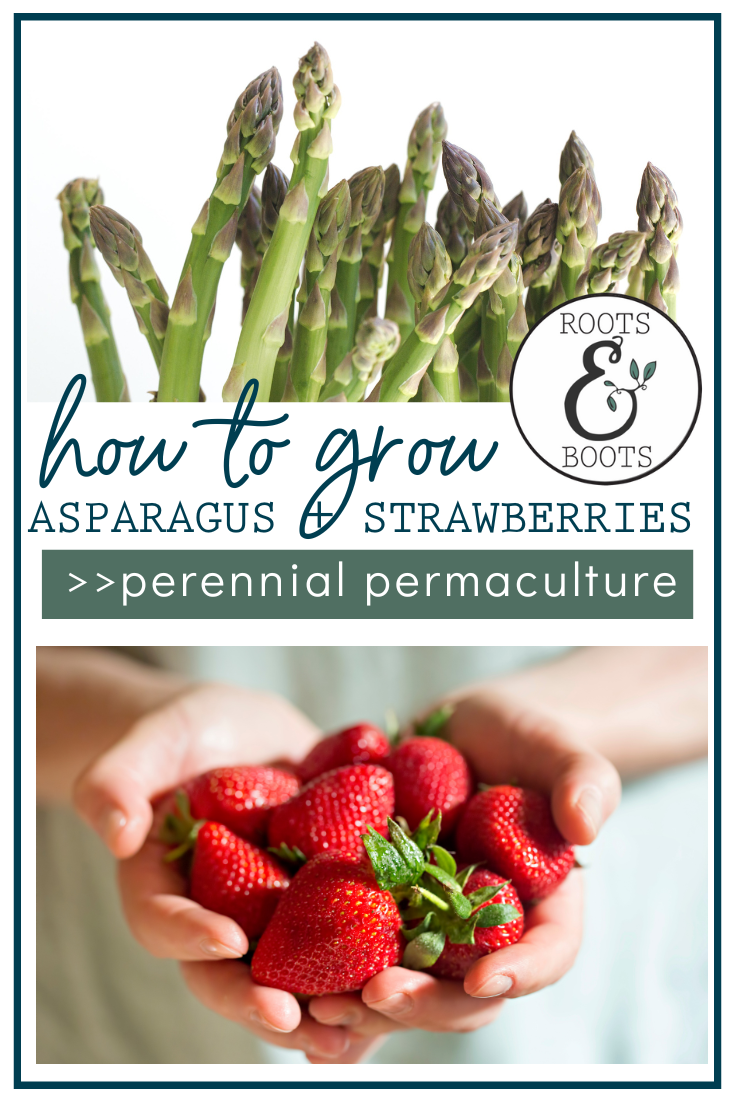
Why grow asparagus with strawberries?
Asparagus and strawberries are both perennials, each with their own growth habit. It makes sense to plant them together, and here’s why:
- Different harvest times: Asparagus is one of the very first harvests of the year, sending up spears in late winter/early spring. Next, June bearing strawberries will produce in mid-to-late spring. After that, the asparagus plants will continue to leaf out and grow large throughout the growing season. Then they’ll do it all over again the following year!
- Different plant heights: Asparagus grows tall and wide while strawberries grow low to the ground, spreading rapidly. The strawberries act as a ground cover to prevent weed growth and produce a delicious crop, all at once.
- Different root zones: Asparagus roots penetrate more deeply into the ground, while strawberry roots stay closer to the surface. This allows both plants to thrive without threatening the other.
This year, I grew my own asparagus from seed, and then planted it in two beds. I added strawberry plants between the asparagus plants to create perennial permaculture beds.
Not all the asparagus plants survived but many of them did. And I’m so impressed at how quickly the strawberries have filled in as the ground cover.
See the entire process in action in the video below! Can’t see the video? Click here to watch.
3 reasons I’m excited to grow asparagus with strawberries
- Perennials = greater output with less input. Less weeding, less planting, less mulching, less work.
- I can’t find unsprayed strawberries in my area, so this is a big step towards growing my own supply for homemade jams.
- I’ve heard fresh, homegrown asparagus doesn’t even compare to store bought or restaurant fare. I can’t wait to taste it! (And am hoping to win over my skeptical menfolk.)
How to plant asparagus with strawberries
- Start seeds or purchase asparagus crowns. You can plant asparagus crowns or try starting your own plants from seed. Here in northern Virginia (zone 7A), I started mine from seed (indoors) on February 2. I use the soil blocking method and started one tray of 50 blocks. 40 seedlings survived. The variety is Martha Washington from Baker Creek.
- Purchase strawberry plants. I started with 50 plants: 25 Honeyo and 25 Earliglow from Stark Bros. Both are June bearing varieties.
- Plant in early spring. I’m in zone 7A and planted my asparagus seedlings and strawberry starts outside on April 9.
- Use a post hole digger. A post hole digger works well for creating planting holes for asparagus seedlings. We aimed to space the holes about 18″ apart in rows about 3-4 feet apart.
- Plant the asparagus. Place one asparagus seedling down inside each post hole. Back fill a little, to cover the root ball. As the plants continue to grow, continue to fill in with dirt until each hole is filled.
- Plant the strawberries. Add one or two strawberry plants between each asparagus plant, and also staggered down the middle of the asparagus rows.
- Mulch well. Cover the bare ground between plants with a thick layer of straw, grass clippings, shredded leaves, etc. Alternatively, see the next step for a living mulch option.
- OR use living mulch. My mulching materials are a hot commodity in spring, and I found myself with a shortage. I got tired of weeding my two asparagus strawberry beds and decided to fill the bare soil with more edible plants like beets and mustard. I chose these two because I had extra seeds to use up and figured what we didn’t eat we could feed to our pigs. I also added annual flowers like zinnia and cosmos because I had volunteer plants coming up all over my garden. Later I sowed green beans along the edges of one bed and transplanted calendula seedlings along the edges of the second bed.
How to use living mulch in asparagus strawberry beds
Mulch is anything that covers the soil. Conventional mulches include straw, grass clippings, leaves, wood chips, pine needles, etc.
Living mulch is simply a grouping of living plants that cover the soil and serve the purpose of mulch: shading the soil, preventing weed growth, reducing water evaporation, and sometimes enriching the soil.
As a bonus, some living mulches can attract pollinators and beneficial insects, while also producing an edible crop.
I recommend choosing annual plants as your living mulch.
I used the following annuals as living mulch:
- beets
- mustard
- zinnia
- cosmos
- calendula
- green beans
Of the six plants I planted as living mulch in my asparagus strawberry beds, my best success came from the beets. Tied for second best were green beans and calendula. Third place goes to the zinnias.
I do not recommend cosmos as a living mulch!
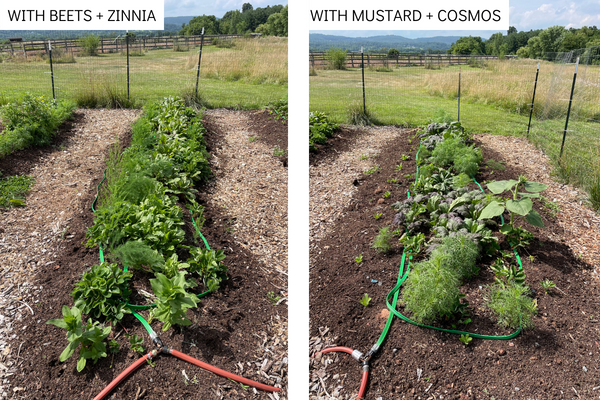
My living mulch choices, ranked
Beets: #1
The beets worked well because they fill in quickly, are compact, do not reseed readily, produce an edible crop, can be harvested as needed, and did not compete with the growth of either asparagus or strawberries. This was my favorite of the living mulches I chose.
Green beans: #2
I liked using green beans to fill in along the edges of the bed with beets and zinnias. They grew taller than the strawberries but not taller than the asparagus, and because green bean plants tend to be leggy, they worked well with the strawberries.
In the picture below, you can see the green bean plants along the left edge of the bed, and then the strawberries, and then the asparagus on the right side.
The reason I ranked green beans higher than calendula is because they produced an edible crop.
Calendula: #3
Calendula was a good choice to fill in the edges of the bed with mustard and cosmos. They added pops of color and did not compete much with the perennial plants.
Mustard: #4
The mustard also worked well to fill in the bare spots and prevent weed growth. However, the mustard grew quickly and eventually went to seed. Now I’m envisioning lots of baby mustard plants in that bed next year!
It’s not necessarily the end of the world, but does feel a bit more complicated than the beets. One way to avoid this is obviously to pull the plants before they go to seed, but I didn’t get around to it.
Zinnias: #5
The zinnias worked well too, as long as I kept them towards the very ends of the beds. Otherwise, they would have shaded out the strawberries or possibly competed with the growing asparagus plants.
Cosmos: not recommended
The cosmos was a complete disaster, and I should have known better! Do you ever try to pretend to yourself that a certain situation will not get out of hand, knowing full well that it will? I pretended to myself that cosmos wouldn’t get huge and try to take over but that’s exactly what happened.
As a result, the bed that included cosmos currently has fewer strawberries than the bed that did not include cosmos. Cosmos is a total beast! The flowers were gorgeous, but the plants got out of hand and shaded out the strawberry starts. I should have pulled them but didn’t.
Thankfully, strawberries are pretty determined to spread, and I think that by next year they will fill in the remaining gaps in that bed. Time will tell!
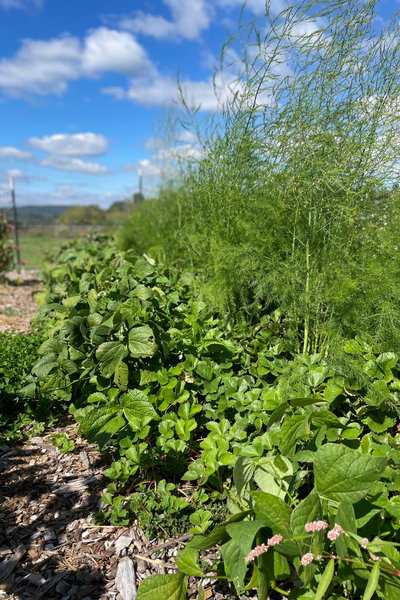
Harvesting from asparagus strawberry beds
Keep in mind that asparagus is a long-range crop. It’s usually recommended to avoid harvesting until year three at the earliest and probably not until year four or after.
However, according to Meg at Seed to Fork and Eliot Coleman in the New Organic Grower, asparagus can be harvested earlier, even one year after planting, by starting your own seed in January/February and planting deeply in early spring.
This is what I’m banking on! As for the strawberries, I’m expecting a good harvest next spring, one year after planting.
Stay tuned to see how our asparagus strawberry patch grows and matures…
More about no-till, permaculture gardening:
- How to Grow Organic, Pest-Free Broccoli
- 6 Tips for Gardening in Heavy Clay Soil
- How to Overcome Squash Vine Borers…Without Chemicals
- 3 Steps to Create Hugelkultur Beds on the Ground
- How to Create Trenched Hugelkultur Beds

Sign up NOW for my best tips delivered weekly to your inbox!
You’ll also get instant access to my library of free ebooks and resources.







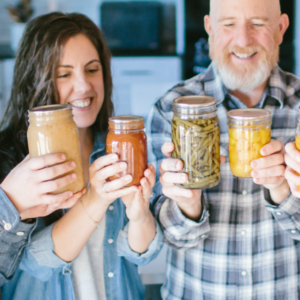
Leave a Comment